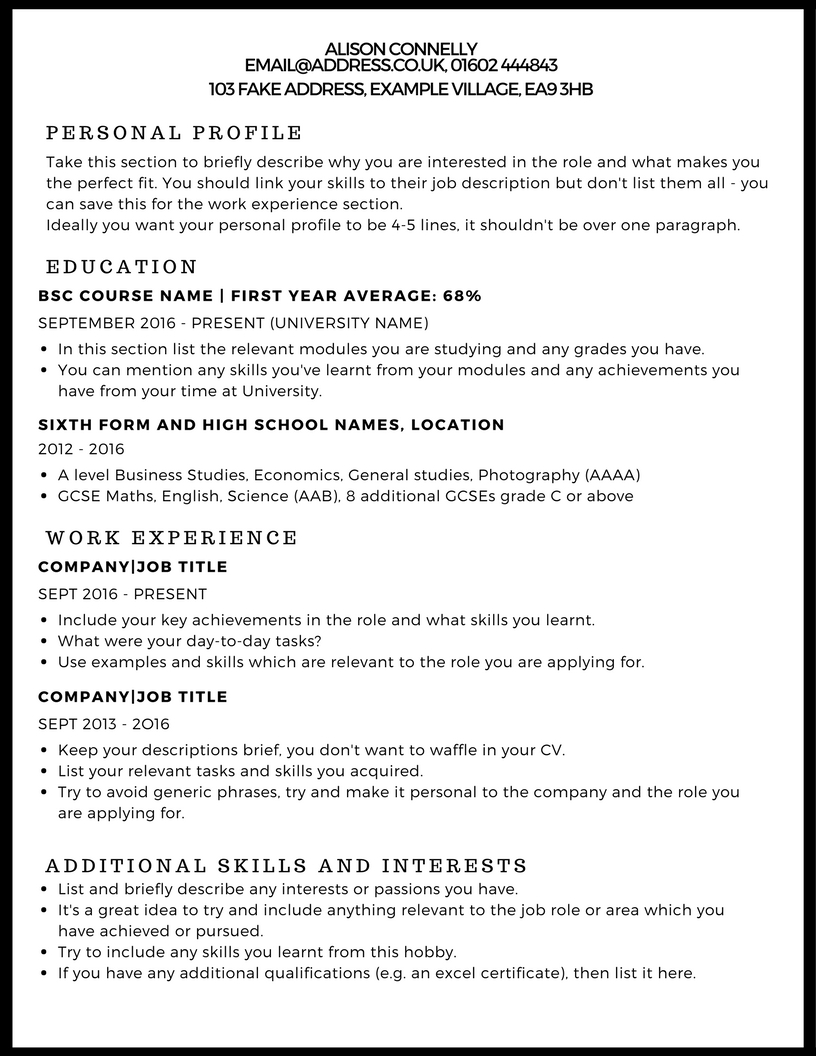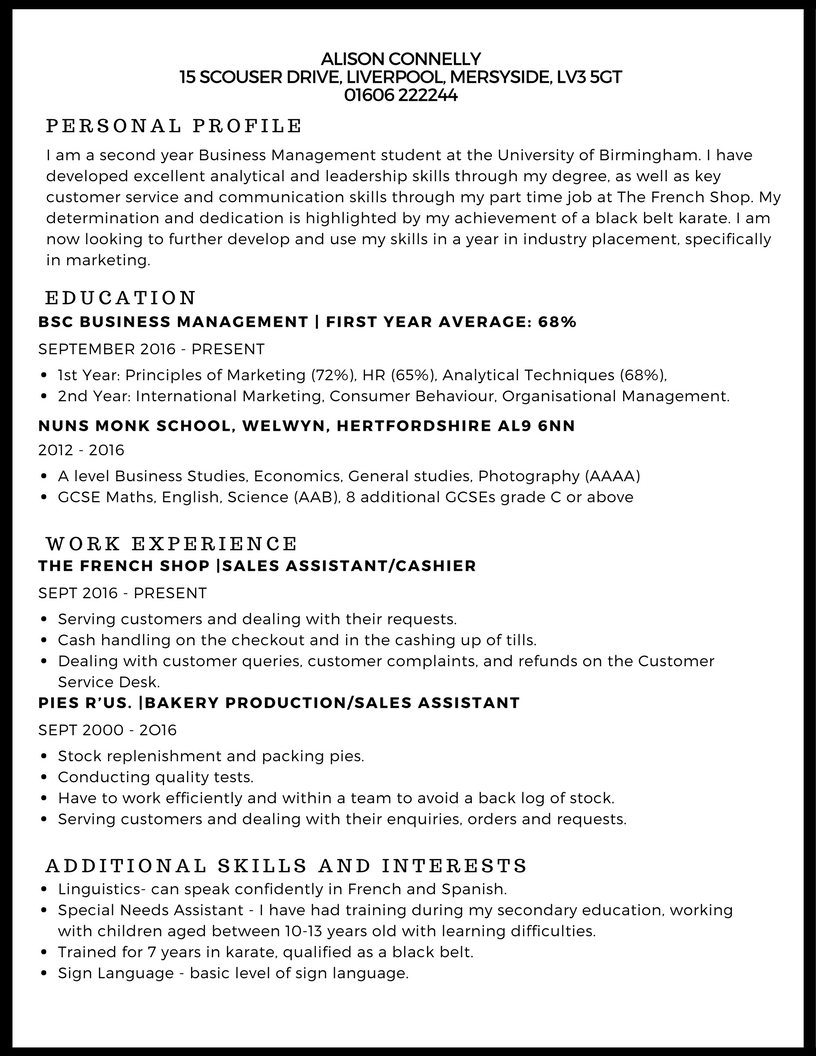The standard structure of a good cv
Your CV (curriculum vitae) is the businesscard you give to the company where you are going to apply, usually combined with your cover letter. Your CV is a sum of short sentences that explain who you are, what you are capable of and what working experience you have. If you do not have any experience with making or delivering a cv, guidelines could be helpful. So, what exactly do you include in your CV?

Personal details
Your personal details are always on top of your CV. At least state your name, address, phone number, e-mail address, marital status, nationality, date of birth and place of birth. Nowadays it is usual, at least, if you are using it in a professional way, to add your LinkedIn and Twitter account.
Studies
State all your relevant studies and courses that you have taken. Start with the last study you were doing or all still doing and work in a chronological way back. State the name of the educational institution, diplomas/degrees you have obtained and the dates.
Work experience
Under the heading work experience will be the enumeration of jobs you have had. The same here, start with the most recent job you have had and work your way back into history. State the name of the companies for which you have worked, the location, the job title you filled and a short job description. Depending on the function you are applying for, leave irrelevant jobs behind.
Knowledge of languages
In your CV, state what languages you speak and for every language indicate a level (in writing and orally) the best lay out is as follows: fluent, good, moderate for oral skills and good, moderate for writing skills.
Computer skills
Indicate what computer programs you control and how well you do it. Think about software packages but specific systems as well.
Interests and other activities
Lastly, state all issues you think are important but have not shown up in your CV yet. Think about hobbies, interests and other relevant topics that say something about you. Do not forget to state your other activities, if you have done any administrative functions or voluntary work, you state this as well of course. Use the last part of your CV to make it as personal as possible.
Does your standard CV look great? Read how you can pimp it to a killer CV.
CV example
A CV (or curriculum vitae) is the first thing an employer will look at from your application. It should reflect your education history, work experience, hobbies and interests. If you’re wondering how to write a cv, take a look at our cv templates below for some inspiration on how to write your own…
We’ve included a free cv template and cv example to ensure you have all the tools required to stand out from the crowd. If you’re not sure about the structure of a good cv, check out our top tips here. Don’t forget to make your application personal and include all your best and relevant experience to guarantee the best chance of success! You can use our CV guide to write your own, then check it against the example in case you are in need of extra ideas. If you've finished your CV, check out our tips for perfecting your cover letter!
CV Guide

Now check out our example CV for any inspiration you may need...
Example CV - Alison Connelly

15 tips to pimp your standard CV
Have you read the standard requirements of making a CV Have you included everything? Then it is about time to adjust your CV to the type of employee and position. We give you fifteen tips to change your basic CV to a successful killer-CV.

Place your contact details: on top of your CV, not only state your contact details but also your e-mail address, your LinkedIn and Twitter account, as long as you use it professionally, or your website URL.
Use a professional e-mail address: supergirl123@hotmail.com is not very representative.
Photo, yes or no?A face is easier to remember between the pile of CV’s but make sure the photo is professional, representative and clearly visible. Don’t you have a picture like this, or not? Ask your closer circle what they think or just don’t use it.
Use hyperlinks in your text: for example to your LinkedIn profile or to a blog or projects you have realized and have online. Select the text that you want to link, click on the right mouse button and choose “hyperlink”. Then fill in the URL of the site you want to link. Note: too many hyperlinks will make your text unreadable and thus will have an adverse effect.
Only include relevant working experience in your CV: An employer in the communication sector might not be interested that you have worked as a shelf stacker. Don’t you have a lot of work experience and are you afraid that your CV will be too short? Just spent more time on extra activities. Maybe you have worked for the school paper or you are very good at Photoshop?
Be honest: There is nothing wrong with over-colouring your CV but never lie. It can come out in the job interview or even after you have been hired. If you still have to apply for other jobs afterwards, this is never a good reference.
Make a basic CV: Write down everything you have done including languages, computer skills and hobbies. Then adjust your CV for every job so that it fits the function requirements in the vacancy.
Do not make it too long: Even though you have done a lot for the past few years, you cannot put everything in your cv. It has to fit on two sides.
Make sure it is clearly aid out: is everything neatly lined out? Does it look clear? Do you have the same enumerations signs everywhere? The lay-out of your CV gives the first impression even before somebody reads your CV. Do not use undue fonts because it distracts from the content.
10. Put your name in the header of the document: double click in the top of the document where you cannot write. Insert a header text and write for example curriculum vitae (your name). Handy when the HR-employee mixes up CV’s
Print your CV: So that you can see if it still looks good this way.
Avoid errors: let somebody who is good at texts read your cv. Just like writing a cover letter, you have become a bit word blind in the end. Somebody else can pick the little mistakes out.
Are you all ready? Save the result as a pdf, this way nobody can change it anymore. It looks way better as well. Use a practical name.
Is your LinkedIn profile still up to date? You have sent a great CV but is it still coherent to what is on your profile? It does not have to all be the same but a future employer should be able to recognize you. Therefore, use the same photo and try to let the purpose shine through.
Look at your last tweets: just check, If you have included your twitter profile on your CV, there is a big chance that a member of HR has taken a look at it. Make sure that your last tweets do not show how big your hangover is and how hard you can curse.